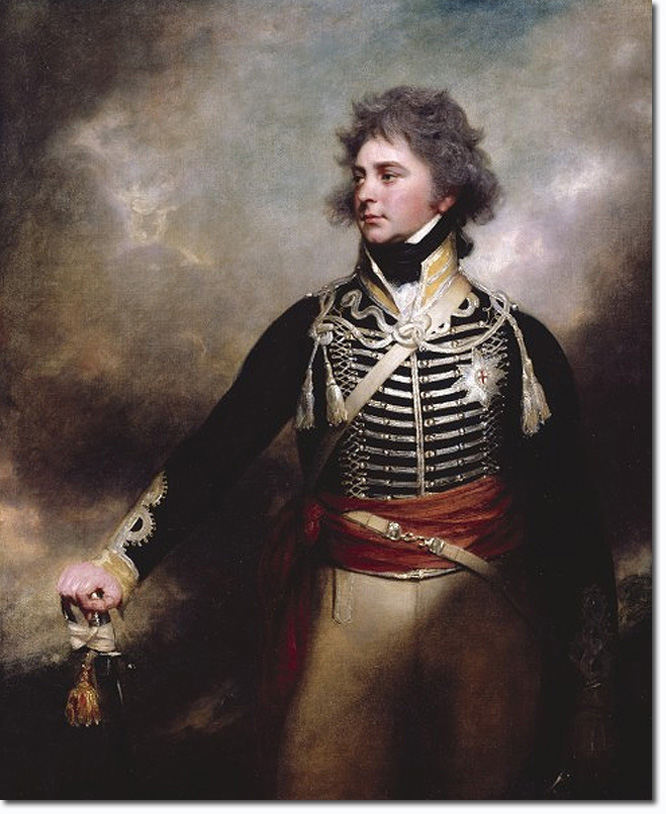|
|


|
|
George Augustus Frederick was born at St James’s Palace on 12 Aug 1762. He was the first child of King George III and Queen Charlotte of Mecklenburg-Strelitz. As heir to the throne he was automatically Prince of Wales. He was intelligent, quickly mastered French, German and Italian as well as his native English. But he had a taste for profligacy and dissipation so that parties and heavy drinking became his preferred way of life. This put him at odds with his father who was more sober and conservative. This followed the 18th century pattern of family relationships in the Georgian court.
When he was 21 in 1783 he was granted 60,000 pounds per annum from parliament and 50,000 from his father. He set up home at Carlton House and became infatuated with Mrs Fitzherbert. She was a Catholic which created a double problem for George. Her religion wouldn’t allow her to be his mistress and the constitution would not permit him to marry her as heir to the throne. So he married her in secret, on 15 Dec 1785. However, it was difficult to keep such a secret safely hidden and it came to a point where George’s political friend, Charles James Fox, had to make a false declaration in parliament to deny the marriage. King George III became mentally ill in 1788 and created a political crisis. After much wrangling, the Regency Bill was passed in 1789 but the King recovered and the idea of a regency was dropped. Meanwhile the Prince’s debts were increasing at an alarming rate and he appealed to his father to help him out. The King refused but later offered a solution. The Prince was to marry his cousin, Princess Caroline of Brunswick. This idea was abhorrent to George but he needed money to support his social life, his lifeblood, so he had to agree. They were married on 8 April 1795. They somehow managed to have one chid, Princess Charlotte, but thereafter lived separate lives. Mrs Fitzherbert remained his real wife, on and off, but he had many mistresses, usually the wives of someone else. In 1810 King George III became mentally ill once more and in 1811 a new Regency Act was passed that gave the 48 year-old Prince of Wales effective rule as Prince Regent, from 5 Feb 1811. The Regency lasted until the death of George III on 29 Jan 1820. But George was no tyrant and under him Parliament attained a higher level of power. The question of Catholic emancipation was high on the agenda, supported by the Whigs but opposed by the Tories who were in power. George was a supporter of the Whigs and although he at first went along with their views, by 1813 he was helping to defeat the Catholic Relief Bill, and later when he was king he came out in open opposition to Catholic emancipation. Things came to a head when Prime Minister the Duke of Wellington grudgingly brought in a Catholic Relief Bill in Jan 1829. George, under the influence of his fanatically anti-Catholic brother, the Duke of Cumberland, refused to give his approval. But he had to give in under intense pressure, and the Act was passed on 13 April 1829. George was extremely self-indulgent, leading inevitably to a drastic and fatal decline in his health. While he was Prince Regent he grew very fat, and this continued until his death. His doctors were kept constantly busy with his many ailments which included gout, cataracts, dropsy, breathlessness etc. Despite his morbid obesity and dependence on drugs like laudanum his appetite did not fail him. In April 1830, two months before his death he was reportedly having a breakfast that consisted of a pigeon and beef steak pie, 3 parts of a bottle of Moselle, a glass of champagne, two glasses of port and a glass of brandy. George was a keen follower, and leader, of fashion. Under his influence the Regency style evolved. The high-necked white cravat became very fashionable after he introduced it to cover his multiple chins. High waisted breeches and ladies dresses became the norm, and brimmed high hats replaced tricorns and bi-corns. He encouraged a foppish dandy look so that gentlemen wishing to attract royal attention did well to dress this way. Cartoonists of the day, like Gillray, had a field day caricaturing the absurdities of dress that paraded in London and Brighton. He was also intensely interested and influential in military fashion. He completely changed the look of the heavy cavalry from long-tailed, heavily buttoned coats and bi-corn hats, to buttonless short jackets and plumed helmets. He was fascinated by hussar dress that was popular in foreign armies but unknown in Britain. His own regiment, the 10th light Dragoons became known as ‘The Prince’s Dolls’ because of his fondness for refining their light dragoon uniforms until they blossomed into full-blown hussars. He relinquished his colonelcy when he became king on 29 Jan 1820. King George IV died on 26 June 1830, succeeded by his brother, the Duke of Clarence, who became King William IV. The portrait of the Prince of Wales was painted by Sir William Beechey in 1798. It is the first version; at least one other version exists, painted in 1803 to update the Prince's appearance. He is wearing the blue dress uniform of the 10th Light Dragoons. |
Armed Forces | Art and Culture | Articles | Biographies | Colonies | Discussion | Glossary | Home | Library | Links | Map Room | Sources and Media | Science and Technology | Search | Student Zone | Timelines | TV & Film | Wargames